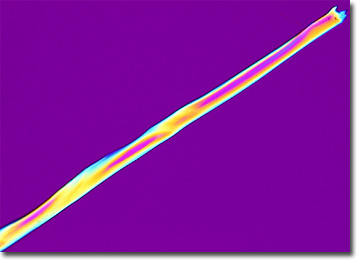Polarized Light Microscopy Digital Image Gallery
Bombyx mori Reeled Silk Fiber
Silk is a valuable, luxurious animal fiber that is widely utilized for high quality clothing and textiles. The art of producing the material, commonly known as sericulture, was first developed by the Chinese several thousand years ago.

The larvae of several moth species belonging to the genus Bombyx produce the vast majority of commercial silk, and the most celebrated of these is the Bombyx mori, which creates the finest fiber. This common silkworm primarily feeds upon the leaves of the mulberry tree and has been so altered by its long history of domestication that it can no longer survive in the wild. The silk it produces is notorious for its whiteness and consistent level of high quality. In contrast, other varieties of silkworms, which have a more varied diet than the Bombyx mori, typically produce thicker fibers in shades of tan, gray, brown, or red.
Silkworms produce their luxurious fiber in a single strand, which is wound tightly into a cocoon and held together with the gelatinous protein sericin. In order to keep the long strands of silk intact, the larvae inside the cocoons are usually destroyed with steam or heat so that they do not emerge as moths. The cocoons are then typically placed in hot water in order to soften the sericin and lightly brushed to find the ends of the strands. After this process has been completed, the strands may be reeled, or unwound, either by hand or through mechanical means. Several silk fibers are usually reeled at one time and twisted together to create thicker, more readily useable strands. Even thicker yarns may be produced if reeled silk subsequently undergoes a procedure called throwing.
